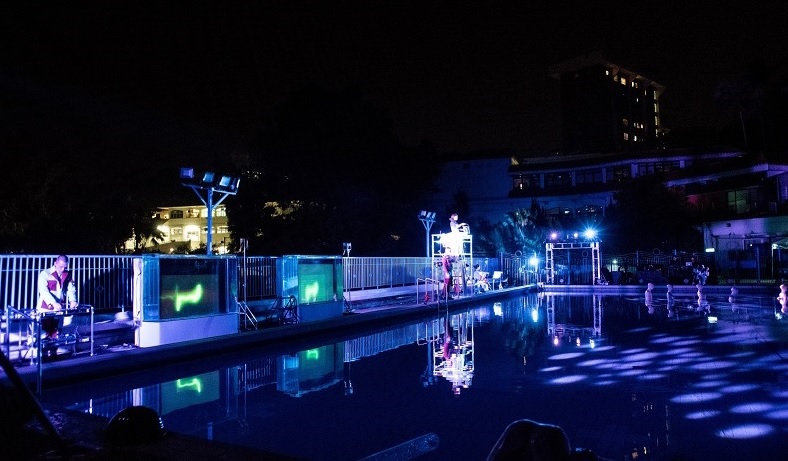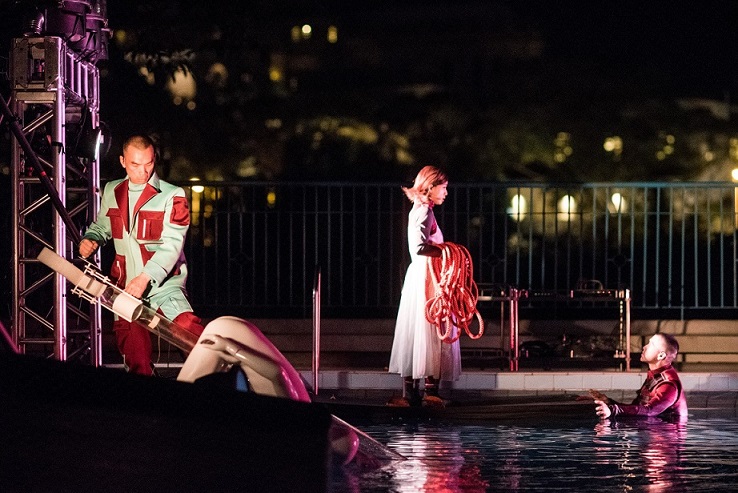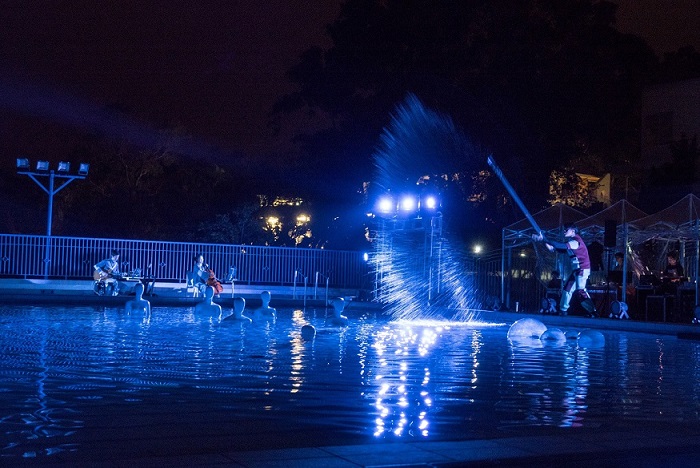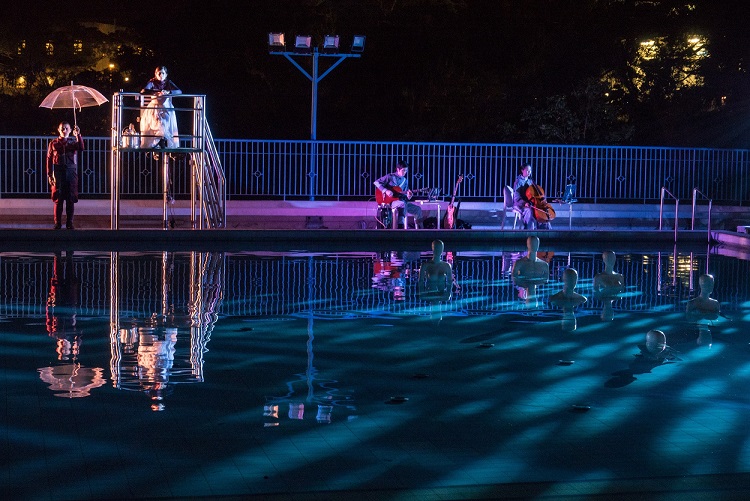Reviews & Articles
Emergency Kit & Wishing Pool – a review
Yang YEUNG
at 10:41am on 23rd May 2019




Captions:
1. – 4. ‘Emergency Kit & Wishing Pool’ media art performance. Images source: Art Promotion Office.
(原文以英文發表,評論「急救箱與許願池」跨媒體藝術表演。)
'Emergency Kit & Wishing Pool' configures a human condition: the ambivalence between contingency (with emergency as special case) and hope (with wish as special case). Can hope conjure despite contingencies not up to us? Can contingencies be staged for rehearsing hope?
Approaching the show in two different ways, I find varying responses to the questions. One approach takes the show as regulated by conventions of the stage as a physical elsewhere. Another approach takes the idea of stage as temporal – an in-between of one event after the next [1]. Each relies on and puts to work different gestures of persuasion.
First reading: the staged on stage
The narrative structure is clear. The show begins with elongated gestures. Blue light cast diagonally across the space as stage (and stage as space) softens the white walls. The cellist’s bow following through a phrase or two sharpens one’s attention. Two actors, each with a staff as long as their bodies prying into the water on the left and right edges of the pool, aim at the aimless – they could be rowing without a boat, or trying in vain to tilt the pool around.
Gradually, the lateral stretch is punctuated by brisker, more pointed movements, as an actor walks up a flight of steps. Having reached the top, she waters the transparent umbrella another actor is holding up. She keeps moving; he stays still. Both maintain a composed manner. Neither is interested to cross the emotional distance between their own solitude and awareness of each other.
The trajectory of straight lines across the stage that the actors have paved is loosened up when she walks down to the pool, carefully and softly stepping onto a floating platform. Weighing down her shoulder is a bundle of thick, red rope. It is not clear if she is onto a life-saving mission, or planning her own escape.
As the platform is pulled from the rim toward the centre of the pool, a video projection on stage right is activated. Some images are abstract, others are suggestive of urban landmarks in Hong Kong. There are also recurrent images of anonymous, genderless figures as individuals and at times also as together – a crowd, alluding to the dummies already installed and immersed in the pool. They all seem to be trapped. A wide, low cascade lies at the bottom of the screen; water rushes out into the pool. In the way the images are fragments, presenting no single linear narrative, they are the actor’s restless ruminations. Her singing voice accentuates this split psychical life she lives. The melodic turn is interjected by the sound of water, beaten as a percussive instrument by another actor. It is from around the water to inside it that the narrative structure unfolds, and finally offers closure.
How is water staged as material and concept in the show?
As a conceptual figure, the ‘wishing pool’, or more conventionally, the wishing well, needs to acquire a flexible but unnameable and immeasurable dimension to receive every wish – every kind of it. A wishing well is more an echo chamber for wishes cast, rippling in silence, carrying the potential of transforming into a wellspring, endlessly expanding into the depth-less and boundless. The figure also suggests intimacy – the more intimate it is, the more tenderness it could offer for the wishes.
Physically, water in a swimming pool is a confined and contained body. The show directs bodies around the water, but not as much into it, or as being subjected to it, blending and messing with it. It’s about water, but not being with it, as if the terrestrial is a little nervous to move close and surrender to it.
The ambivalence in engaging with water culminates into images of a foetus toward the end of the show – images suggestive of how one listens involuntarily and unconsciously to the gurgling water in the womb. Would and should water flow, or had it rather stayed still?
There is a lot of potential at multiple points in 'Emergency Kit & Wishing Pool' for water to be freed from this confinement and set to work as an escape, a rebel, a shelter, a mirror… I wonder if at times, the pool is burdened with too much of what is required of the presence of the stage to lose sight of its conceptual promise and physical force.
Second reading: freeing the stage, freeing the pool as stage.
Here, the story begins otherwise: from how the night sky is perceived, to engaging with the city’s rhythms that could be discerned in nuances that the day does not offer.
I was on a double-decker bus speeding from south to north on Pokfulam Road. As the bus passed Queen Mary Hospital, the lanes became evidently less populated with traffic. The sky opened up more with fewer tall buildings on the sides.
I rang the bell for my stop. The bus engine stopped growling. Getting off, I noticed the street lamps around me and those lighting up Bethany on the opposite side of the road becoming particularly yellow-orange. I turned right and was greeted by the quietude of the much narrower Pokfulam Reservoir Road. The view to the end of the road is blocked. But street lamps at a distance suggest the path keeps opening up. I heard dripping water, the soft moaning of a horse, and some footsteps of probably my fellow audience.
The venue has a long name – Hong Kong PHAB Association Jockey Club PHAB Camp. I never saw these words. It was the ushers standing at the door that guided our way. Through the parking lot, all of a sudden, the swimming pool came into sight. I found myself on a higher vantage point to be able to see the entire facility, as if looking at the expanse of a field. From there, the pool appeared surprisingly small. I strolled along the spiralling walkway downward. There, we settled on the low steps on the long side of the swimming pool.
There are two kinds of site specificity at work. The first is that the show creates the presence of an elsewhere. It responds to the space as a set of dimensions, as built. Another kind of site specificity attends to the way the site is, has been, and might be lived.
To move from the bustle of the city during the day into the equanimity of an enclave is to be affected by shadows. This is often said to be the distinction between space and place – this place for swimming bodies of varying abilities, playing, practicing, feeling weightless, at random and spontaneous distances to each other.
In Rhythmanalysis: space, time, and everyday life, Henri Lefebvre makes a decisive claim, “Everywhere where there is interaction between a place, a time, and an expenditure of energy, there is rhythm.” (1992/2014:15) Rhythm is not only a succession of mechanical movements, but much more complicated and nuanced, and full of meaning, than the “reign of the commodity” (2004:7) could present. Listening to a Mediterranean city, Lefebvre says these the linear and cyclical rhythms “enter into perpetual interaction and are even relative to one another, to the extent that one serves as the measure of the other.” (2004:90) In both, there are the movements of returning, but it is in the cyclical that the returning is often a ‘beginning again’, as a ‘becoming’. (ibid.) If 'Emergency Kit & Wishing Pool' is considered as a production of rhythms arising out of the way the site is lived and not only its function and architecture, I wonder if a will to stage moving forward (linear rhythm) leaves the place behind (cyclical, in the sense of embodying the potential to return and become something else). Sonically, the piece at times presents itself like a march, with a structured rhythm over-riding possibilities of spilling over, of excess, as if the linear has reasons to dominate the micro and multiple cyclical rhythms at times. Does it? And does the perpetual interaction Lefebvre refer to require equality of the two? I wonder.
Have all these resolved the question of ambivalence between contingency and hope? Could it? The artist places hope and optimism together in one stroke in the program notes. To “offer treatment to [people’s] hope”, he remains optimistic. I would propose that if moving forward and offering closure is optimism, the show is auditioning hope rather than offering a method to it, let alone distributing it, for optimism is to blindly believe everything will turn out fine, while to hope is to commit to a possible future with one’s agency involved, despite uncertainty and incommensurability. It is more sticky business than optimism. It seems to me what’s staged is the ongoing struggle between contingency and hope, rather than a resolution.
But then, what’s staged is not all that is going on. If one looks also in the artistic process, the baseline might shift to how the artist has been transformed, how his life enriched as ours do. It’s not just the staged, but what is co-extensive with it off-stage, that art is. Perhaps something else has long begun. I am curious how the show might begin again from where it is left off.
Coming out of the show, with nowhere to escape but slabs of neon lights screaming for attention only to mute and mutilate each other, I appreciate the enclave that is both for the wish and for emergency more. One could even imagine hovering in the night sky, spotting the wishing well as a shimmering dot, hearing a chime, bathing in its nocturnal being.
NOTES
[1] I have been inspired by Jose Esteban Munoz’s Cruising Utopia: The Then and There of Queer Futurity. New York: New York University Press, 2009:98.
*This review was invited by the Hong Kong Visual Arts Centre
